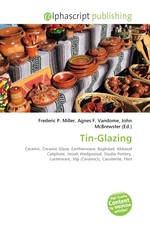Tin-Glazing
Frederic P. Miller, Agnes F. Vandome, John McBrewster
бумажная книга
High Quality Content by WIKIPEDIA articles! Tin-glazing is the process of giving ceramic items a tin-based glaze which is white, shiny and opaque, normally applied to red or buff earthenware.The opacity and whiteness of tin glaze make it valued by its ability to decorate with colour. The earliest tin-glazed pottery appears to have been made in Abbasid Iraq (750-1258 AD)/Mesopotamia in the 9th century, the oldest fragments having been excavated during the First World War from the palace of Samarra about fifty miles north of Baghdad. From Mesopotamia, tin glazes spread to the Islamic Egypt (868–905 AD) during the 10th century, and then to the Islamic Spain (711-1492 AD), leading to the maximum development of Islamic lusterware. The history of tin glazes in the Islamic worlds is disputed. One possible reason for the earlier production of tin-glazed wares could be attributed to the trade between the Abbasid Empire and ancient China from the 8th to 9th century onwards, resulting in imitation of white Chinese stoneware by local Islamic potters.
Данное издание не является оригинальным. Книга печатается по технологии принт-он-деманд после получения заказа.


